Have you ever wondered where the tropical paradise of Boracay is located? Is it nestled in the heart of the Pacific Ocean or tucked away in a remote corner of the world? Prepare to be amazed as we unveil the intriguing whereabouts of this breathtaking island.
Boracay is not just a figment of your imagination; it is a real haven situated in the Western Visayas region of the Philippines. This idyllic getaway sits merely 0.8 kilometers (0.50 mi) off the northwest coast of Panay, drawing travelers from far and wide to experience its unparalleled beauty.
Spanning a land area of 10.32 square kilometers (3.98 sq mi), Boracay falls under the jurisdiction of three barangays in Malay, Aklan. The island is renowned for its powdery white sand beaches and crystal-clear turquoise waters, making it the epitome of paradise for those seeking relaxation and tranquility.
Key Takeaways:
- Boracay is located in the Western Visayas region of the Philippines.
- The island is situated 0.8 kilometers (0.50 mi) off the northwest coast of Panay.
- Boracay has a total land area of 10.32 square kilometers (3.98 sq mi) and is divided into three barangays in Malay, Aklan.
- The island is known for its white sand beaches and crystal-clear waters.
- Boracay is a popular destination for tourists seeking relaxation and tranquility.
Geography and Coordinates of Boracay
Located in the Western Visayas region of the Philippines, Boracay is a tropical paradise nestled in the heart of the archipelago. With its picturesque landscapes and breathtaking seascapes, this island gem offers an enchanting retreat for travelers from around the world.
Spanning across coordinates 11°58′8″N 121°55′26″E, Boracay is strategically positioned to showcase the beauty of the surrounding seas. It is bordered by the Jintotolo Channel, Sibuyan Sea, Sulu Sea, and Tablas Strait, ensuring a mesmerizing coastal experience no matter where you turn.
The island itself boasts a diverse geography, with lush forests, rolling hills, and pristine beaches that stretch for miles. At its highest point, Mount Luho rises to 302 feet (92 meters), providing visitors with a panoramic view of the island and its magnificent surroundings.
Boracay is an integral part of the Aklan province, and it is divided into three barangays: Balabag, Manoc-Manoc, and Yapak. Each barangay offers its own distinctive charm and attractions, contributing to the island’s vibrant and multicultural atmosphere.
Whether you’re seeking adventure or relaxation, Boracay’s geography sets the stage for an unforgettable escape. From its crystal-clear waters to its verdant landscapes, this island paradise invites you to immerse yourself in its natural wonders.
Population and Ethnicity
In terms of population, Boracay has seen steady growth over the years. As of 2020, the island is home to approximately 37,802 residents. This figure includes both locals and foreign residents who have chosen to make Boracay their home.
Boracay is not only a haven for tourists but also a melting pot of diverse ethnic groups. The island is proud to celebrate its cultural diversity, with various ethnic communities living side by side. The prominent ethnic groups found in Boracay include the Ati, Aklanon, Hiligaynon, and Karay-a.
The Ati people, in particular, hold a special significance as the indigenous inhabitants of Boracay. They have a deep connection to the island’s history and cultural heritage. However, due to commercial development and tourism, the Ati community has faced challenges and marginalization over the years.
Efforts are being made to preserve and revitalize the cultural heritage of the Ati people. Various initiatives, including cultural festivals and educational programs, aim to raise awareness about their traditions and promote inclusivity. By showcasing their unique customs and traditions, Boracay seeks to ensure the Ati community’s rightful place within the island’s vibrant tapestry of cultural diversity.
Preserving Cultural Heritage: Ati-atihan Festival
One of the key events that celebrate the Ati culture is the Boracay Ati-atihan Festival. This annual festival showcases the vibrant traditions and rituals of the Ati people. It serves as a platform to educate both locals and tourists about the rich cultural heritage that the Ati community brings to Boracay.
The Boracay Ati-atihan Festival features colorful costumes, energetic dance performances, and captivating music. The streets come alive with jubilant parades and processions that evoke a sense of pride and unity. This festive event not only entertains but also fosters understanding and appreciation for the Ati culture.
The Boracay Ati-atihan Festival is a testament to Boracay’s commitment to preserving its cultural heritage. By engaging with and supporting the Ati community, Boracay aims to create a sustainable future that respects the island’s indigenous roots and diverse ethnic groups.
Tourism and Awards
Boracay is renowned for its tourism offerings and has received numerous accolades. It was awarded as the Best Island in the World by Travel + Leisure in 2012 and was listed as one of Condé Nast Traveler’s Best Islands in the World in 2014. The island is known for its pristine beaches, vibrant nightlife, and tranquil atmosphere, attracting tourists from around the globe.
With its breathtaking natural beauty and world-class hospitality, Boracay has become a highly sought-after destination for travelers seeking a tropical paradise. Its crystal-clear waters, powdery white sand, and lush landscapes make it a perfect getaway for beach lovers and nature enthusiasts.
“Boracay is a true gem in the Philippines. Its picture-perfect beaches and vibrant culture make it an unforgettable destination for travelers of all kinds.” – Travel + Leisure
Whether you’re looking for relaxation or adventure, Boracay has something for everyone. You can spend your days lounging on the beach, indulging in water sports like snorkeling and diving, or exploring the island’s scenic hiking trails. After the sun sets, the island comes alive with its vibrant nightlife, offering a wide range of restaurants, bars, and clubs for visitors to enjoy.
As a top tourist destination, Boracay has continually invested in its tourism infrastructure to provide visitors with world-class facilities and services. The island boasts a wide range of accommodations, from luxurious resorts to budget-friendly hotels, ensuring that every traveler can find the perfect place to stay.
Table: Top Awards Won by Boracay
| Award | Year | Organization |
|---|---|---|
| Best Island in the World | 2012 | Travel + Leisure |
| Best Islands in the World | 2014 | Condé Nast Traveler |
| Best Beach Destination | 2016 | World Travel Awards |
With its stunning natural landscapes, warm hospitality, and recognition as a top destination, it’s no wonder that Boracay continues to attract tourists from all over the world. Whether you’re seeking a relaxing beach vacation or an exciting adventure, Boracay is the perfect place to unwind and create unforgettable memories.
Explore Boracay’s Pristine Beaches
Boracay is home to some of the most stunning beaches in the world. Here are a few must-visit beaches on the island:
- White Beach: This iconic beach stretches for 4 kilometers and is famous for its soft white sand and crystal-clear waters. It offers a range of water activities and is the perfect spot to laze under the sun.
- Puka Shell Beach: Tucked away on the northern side of the island, Puka Shell Beach is known for its abundance of puka shells. It offers a more serene and secluded setting.
- Diniwid Beach: Located just a short walk from White Beach, Diniwid Beach is the perfect escape for those seeking a quieter atmosphere. It offers calm waters and beautiful views.
Whether you choose to lounge on the famous White Beach or explore the hidden gems of Puka Shell Beach and Diniwid Beach, Boracay’s beaches are sure to leave you mesmerized.
Closure and Rehabilitation
In April 2018, the Philippine government made the difficult decision to close Boracay for a six-month period to undergo major renovation works. The closure was necessary to address critical issues on the island, particularly its sewage system, and to implement long-term solutions for sustainability and environmental preservation. This proactive approach aimed to ensure that Boracay remains a top tourist destination for years to come.
The closure period allowed authorities to not only upgrade the island’s infrastructure but also to implement new rules and regulations that prioritize eco-friendly practices. These measures were put in place to protect the fragile ecosystem and preserve the natural beauty that attracts visitors from around the world.
After months of extensive renovation and rehabilitation efforts, Boracay officially reopened its shores to the public in October 2018. The island emerged with a renewed commitment to sustainable tourism, offering visitors a chance to experience its breathtaking beaches and pristine surroundings while minimizing their impact on the environment.
This closure and renovation period served as an opportunity to create a more responsible and conscientious approach to tourism on Boracay. By carefully managing visitor numbers, implementing waste management strategies, and enforcing regulations, the island now strives to maintain its balance between tourism and environmental conservation.
Boracay’s closure and rehabilitation have been successful in addressing immediate concerns while paving the way for a brighter and more sustainable future. The dedication to preserving Boracay’s natural beauty ensures that this tropical paradise will be enjoyed by generations to come.
“The closure and rehabilitation of Boracay have transformed the island into a shining example of sustainable tourism.” – Environmental Conservation Magazine
| Significant Achievements of Boracay’s Closure and Rehabilitation | Impact |
|---|---|
| Upgraded sewage system | Improvement in water quality, minimizing pollution |
| Enforced regulations on waste management | Reduction in marine debris and beach pollution |
| Implemented carrying capacity limits | Preservation of the island’s ecosystem and prevention of over-tourism |
| Educated and trained local businesses on sustainable practices | Increased awareness and adoption of eco-friendly initiatives |
Boracay Ati-atihan Festival
The Boracay Ati-atihan Festival is a vibrant celebration of the cultural heritage of the Ati indigenous people, which takes place annually on the beautiful island of Boracay. This festival attracts a large number of tourists from around the world who come to witness the colorful and lively festivities.
During the Boracay Ati-atihan Festival, participants adorned in elaborate costumes portray the history, traditions, and stories of the Ati people through energetic dances and theatrical performances. The rhythmic beats of traditional drums fill the air as locals and visitors join together in jubilant revelry.
The Boracay Ati-atihan Festival is a testament to the rich cultural diversity of Boracay and serves as a platform to preserve and promote the indigenous heritage of the Ati people. It is a celebration of their resilience, artistry, and sense of community.
The Ati-atihan Parade
One of the highlights of the Boracay Ati-atihan Festival is the grand parade, where groups of performers, known as “tribes,” roam the streets of Boracay. These tribes showcase their distinct costumes, face paints, and accessories, representing different aspects of Ati culture and history.
The streets come alive with vibrant colors and pulsating music as the tribes dance and sing their way through the festival route, creating an immersive and captivating experience for spectators. The festive atmosphere, coupled with the rhythmic performances, creates a sense of unity and joy.
Record-Breaking Attendance
In January 2024, the Boracay Ati-atihan Festival witnessed a record-breaking attendance of 36,741 people, further cementing its status as one of the most anticipated cultural events in the Philippines. This remarkable turnout reflects the growing interest and appreciation for the Ati-atihan Festival and its significance in promoting Boracay as a major tourism attraction.
The Boracay Ati-atihan Festival not only offers a glimpse into the rich cultural heritage of the Ati people but also provides a unique opportunity for visitors to immerse themselves in the local traditions and festivities. It showcases the spirit of Boracay, where diverse cultures come together to celebrate and create lasting memories.
Etymology of Boracay
The name Boracay holds various origins, each contributing to the island’s rich history and cultural significance. According to the indigenous Ati people, the name Boracay is derived from the Inati words “bora” meaning “bubbles” and “bocay” meaning “white.” This interpretation emphasizes the island’s pristine white sand beaches, which are renowned worldwide.
Another theory suggests that Boracay’s name originated from the local word “borac,” which translates to “white cotton.” This description aptly captures the appearance and texture of the island’s soft and powdery sand, likening it to the purity of cotton fibers.
“The name Boracay is attributed to different origins. According to the island’s indigenous Ati people, it comes from the Inati words ‘bora’ (bubbles) and ‘bocay’ (white). Another theory suggests it originated from the local word ‘borac,’ which means ‘white cotton,’ referring to the color and texture of Boracay’s sand.”
There is also a version connecting Boracay’s name to the Spanish era, where it is believed to be derived from words signifying shell and seed, reflecting the island’s abundant marine life and fertile surroundings.
The etymology of Boracay reflects the harmony between its natural wonders and cultural heritage, symbolizing the beauty and allure that draw visitors from all over the world.
Historical Significance
The diverse interpretations of Boracay’s name add to its historical significance, highlighting the island’s roots and the indigenous cultures that have inhabited it for centuries. Understanding the etymology of Boracay enables us to appreciate the island’s deep connections with nature, language, and local traditions.
Pre-colonial Period
Before the Spanish colonization in the 16th century, Boracay was a vibrant island inhabited by the Ati people, also known as the Aeta or Ata. The Ati were the indigenous people of Boracay, and they had a deep connection with the land and the sea surrounding the island. They lived harmoniously with nature, engaging in rice cultivation and raising animals for sustenance.
The Ati people had a rich culture and practiced sustainable ways of living. They were skilled fishermen and hunters, relying on the ocean and forests for their livelihood. The Ati communities on Boracay were self-sufficient and had a close-knit social structure. They had their own unique language, traditions, and rituals that were passed down through generations.
During this pre-colonial period, life on Boracay was relatively untouched by external influences. The Ati and Tumandok people, another indigenous group in the area, coexisted peacefully and established a strong indigenous presence on the island.
“The Ati people, the indigenous inhabitants of Boracay, lived in harmony with nature and had a deep connection with the island.”
The Ati culture and way of life revolved around their strong spiritual beliefs. They believed in the presence of spirits in nature and practiced animism. Various rituals and ceremonies were performed to honor these spirits, seek their guidance, and ensure the well-being of their communities.
The arrival of the Spanish conquistadors in the 16th century marked a significant turning point in Boracay’s history. The Spanish called the island “Buracay” and began establishing settlements, introducing Christianity, and imposing their own system of governance. The indigenous communities gradually assimilated into the Spanish colonial society, resulting in the erosion of their cultural practices and traditions.
The Ati People: Guardians of Boracay’s Heritage
Despite the challenges faced by the Ati people over the centuries, efforts are now being made to preserve and celebrate their cultural heritage. Various organizations and initiatives are working hand in hand with the Ati communities to revitalize their traditions, language, and arts.
The Ati-atihan Festival, a significant cultural event held in Boracay, plays a vital role in showcasing the Ati heritage. During the festival, locals and tourists come together to witness vibrant parades, dances, and music, all paying homage to the island’s indigenous roots.
“The Ati people are the guardians of Boracay’s cultural heritage and are working to revitalize their traditions and language.”
Today, the Ati people continue to be the stewards of their ancestral land, incorporating their indigenous knowledge into sustainable tourism practices on Boracay. Their role as the guardians of the island’s cultural heritage ensures that future generations can appreciate and learn from Boracay’s rich pre-colonial history.
| Key Points | Details |
|---|---|
| The Ati People | The indigenous inhabitants of Boracay |
| Pre-colonial Life | Engaged in rice cultivation and animal raising for sustenance |
| Spiritual Beliefs | Practiced animism and believed in the presence of spirits in nature |
| Cultural Revitalization | Efforts to preserve Ati traditions, language, and arts |
| Ati-atihan Festival | A celebration of the Ati culture and heritage |
Contemporary Period and Agricultural Background
Boracay, known for its stunning beaches and vibrant tourism, was once primarily an agricultural community before the influx of tourists. The island belonged to the province of Capiz and was under the jurisdiction of the town of Buruanga.
Agriculture played a significant role in Boracay’s economy, with copra production and fishing being the main industries. Copra, the dried meat of coconuts, was a valuable commodity that fueled economic growth. Fishermen took to the abundant waters surrounding the island to provide for the agricultural community.
However, the unchecked overharvesting and destructive fishing practices took a toll on Boracay’s fishing industry. The marine ecosystem began to suffer, and fish populations declined. It became evident that sustainable fishing practices were necessary to preserve both the environment and livelihoods.
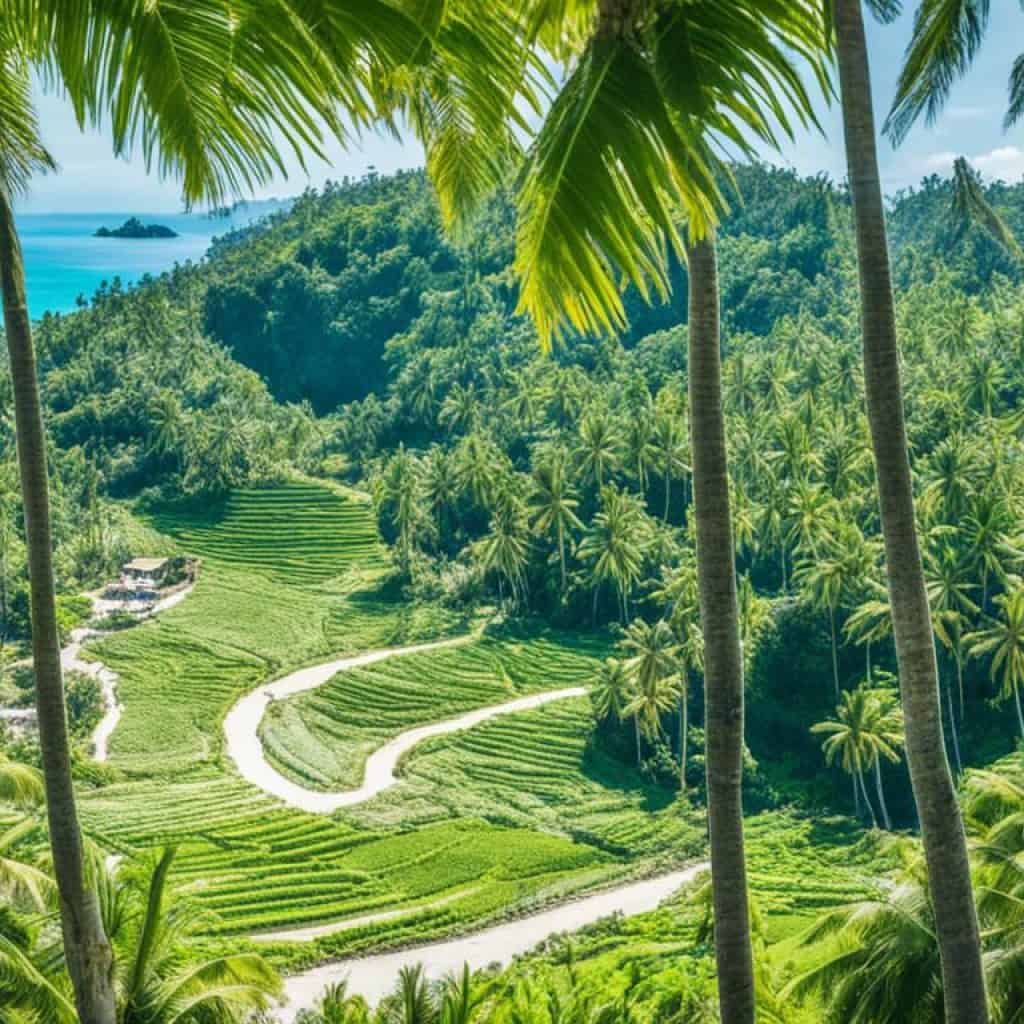
To combat the decline, local authorities implemented regulations and initiatives to protect marine life and promote sustainable fishing practices. These efforts included establishing marine protected areas, enforcing fishing limits and restrictions, and educating the fishing community about the importance of conservation.
“Preserving Boracay’s natural resources is crucial for the long-term sustainability of the island. By implementing sustainable fishing practices, we can ensure that future generations can continue to enjoy the bountiful marine life that Boracay has to offer.”
These measures, combined with ongoing environmental awareness campaigns, have helped revive Boracay’s fishing industry. Today, fishermen are encouraged to embrace sustainable practices, such as using selective fishing gear and following seasonal fishing bans, to protect marine biodiversity.
| Year | Fishing Industry Revenue (in PHP) |
|---|---|
| 2010 | 50,000,000 |
| 2015 | 45,000,000 |
| 2020 | 65,000,000 |
The table above illustrates the positive impact of sustainable fishing practices on Boracay’s fishing industry revenue. By embracing conservation efforts, the industry has experienced steady growth, demonstrating the potential for economic prosperity while preserving the island’s natural resources.
Boracay’s transition from an agricultural community to a world-renowned tourist destination has brought economic prosperity. However, it is essential to strike a balance between the booming tourism industry and the preservation of the island’s rich biodiversity. Through sustainable practices, Boracay can continue to thrive as a model for responsible tourism.
Influx of Tourism
The 1970s marked the beginning of a vibrant tourism industry on Boracay, attracting visitors from around the world. The island’s rise to prominence can be attributed to its enchanting beauty, as showcased in popular films, and the positive reviews of German writer Jens Peter. As a result, Boracay emerged as a sought-after destination for budget travelers in the 1980s.
Boracay’s allure lies in its pristine white sand beaches and crystal-clear waters, earning it a reputation for having some of the world’s best coastal landscapes. Tourists were captivated by the tropical paradise, which offers a perfect blend of relaxation and adventure.
However, the surge in tourism also brought about challenges. In 1997, concerns arose regarding the island’s poor sewage systems and their impact on the environment. As a result, tourist arrivals declined, prompting the need for measures to address these issues effectively.
“Boracay’s popularity among tourists grew exponentially in the 1970s and 1980s, drawing in budget travelers and adventurers alike. The island’s breathtaking beaches and tranquil atmosphere have made it a beloved destination for those seeking a tropical paradise experience.”
Efforts were made to improve the island’s infrastructure, focusing on upgrading sewage systems and instituting environmental regulations. These initiatives aimed to mitigate the negative impact of tourism on Boracay’s natural resources, ensuring its long-term sustainability as a premier holiday spot.
| Year | Tourist Arrivals |
|---|---|
| 1970 | 15,000 |
| 1980 | 120,000 |
| 1990 | 250,000 |
| 2000 | 600,000 |
| 2010 | 1,200,000 |
“The influx of tourists to Boracay has been a double-edged sword. While it has brought economic growth and development to the island, it has also put a strain on its infrastructure and natural resources. Sustainable measures are essential to strike a balance between tourism and environmental conservation.”
Boracay’s journey as a world-class tourist destination is a testament to its enduring allure and the commitment of its stakeholders to preserving its natural beauty. With the right balance between tourism and sustainable practices, Boracay continues to offer an unforgettable travel experience for visitors from all corners of the globe.
Boracay’s Transformation and Renovation
Boracay has undergone significant transformation and renovation efforts to address environmental issues and ensure its long-term sustainability. In 2005, the island was declared a Special Tourism Zone, marking a milestone in its development.
Recognizing the importance of preserving and protecting Boracay’s natural resources, then-president Gloria Macapagal Arroyo spearheaded initiatives to tackle environmental challenges. These included the installation of a modern water supply system, sewage treatment plant, and solid waste disposal system.
These infrastructure upgrades aimed to improve waste management, enhance water quality, and reduce pollution on the island. The implementation of these systems marked a crucial step towards mitigating the environmental impact of increasing tourism.
The recent closure and renovation in 2018 further demonstrated Boracay’s commitment to preserving its unique ecosystem. During this six-month closure, extensive measures were taken to address environmental issues and promote sustainable practices.
“Boracay is a jewel of the Philippines, and we must take every measure to protect its beauty and ensure its long-term viability as a tourism destination,” said Department of Environment and Natural Resources Secretary Roy Cimatu.
The comprehensive renovation focused on various aspects, including upgrading the sewage and drainage systems, enforcing stricter regulations on construction and land use, and implementing a carrying capacity limit to manage the influx of tourists.
Furthermore, the closure period allowed for the rehabilitation of the island’s vegetation and coral reefs, enhancing Boracay’s natural beauty and preserving its role as a thriving marine ecosystem.
After the completion of the renovation, Boracay reopened with new rules and regulations aimed at fostering sustainable tourism practices. These measures included the banning of single-use plastics, stricter waste management protocols, and stricter enforcement of environmental laws.
Overall, Boracay’s transformation and renovation efforts have significantly improved the island’s environmental conditions and set a precedent for sustainable tourism in the Philippines. The ongoing commitment to conservation ensures that future generations can continue to enjoy the pristine beauty of Boracay’s beaches while safeguarding its delicate ecosystem.
Current State and Sustainable Practices
Boracay is committed to maintaining its pristine condition and promoting sustainable practices to ensure the long-term preservation of its natural beauty. Various initiatives are being implemented to enhance sustainability and environmental conservation on the island.
Efforts are underway to reduce plastic waste and promote the use of biodegradable products. Local businesses are encouraged to switch from single-use plastics to eco-friendly alternatives, such as biodegradable cutlery and packaging. This initiative aims to minimize the impact of plastic pollution on Boracay’s beaches and marine ecosystem.
In addition to reducing plastic waste, Boracay is also introducing electric tricycles as an eco-friendly mode of transportation. These electric vehicles produce zero emissions, helping to reduce air pollution and noise levels on the island. This initiative aligns with Boracay’s commitment to sustainable tourism and creating a clean and healthy environment for both residents and visitors.
Boracay prioritizes the preservation of its diverse ecosystems by implementing responsible tourism practices. The island’s marine and coastal areas are protected through the establishment of marine sanctuaries and preservation zones. These protected areas promote the conservation of marine biodiversity and provide sustainable livelihood opportunities for local communities.
Boracay’s Sustainable Tourism Strategy
“We believe that sustainable tourism is the key to preserving Boracay’s natural beauty for future generations. By implementing eco-friendly practices and raising awareness about environmental conservation, we strive to create a balance between tourism and the protection of our fragile ecosystems.”
– Local Tourism Organization Representative
The local government and tourism stakeholders in Boracay are dedicated to educating visitors about the importance of sustainable practices. Environmental awareness campaigns and educational programs are conducted to promote responsible tourism behavior, such as proper waste disposal and respect for the island’s natural resources.
Boracay’s commitment to sustainability extends beyond the tourism sector. The local community actively participates in beach clean-up drives and reforestation projects to restore and preserve the island’s natural habitats. By involving residents, businesses, and visitors in environmental conservation efforts, Boracay aims to create a culture of sustainability that will ensure the island’s beauty for years to come.
| Sustainable Practices in Boracay | Benefits |
|---|---|
| Reducing plastic waste | Preserving the pristine beaches and protecting marine life from pollution |
| Promoting the use of biodegradable products | Minimizing the environmental impact of disposable items |
| Introducing electric tricycles | Reducing air and noise pollution on the island |
| Establishing marine sanctuaries and preservation zones | Protecting marine biodiversity and supporting sustainable livelihoods |
| Conducting environmental awareness campaigns | Encouraging responsible tourism behavior and waste management |
| Engaging the local community in clean-up drives and reforestation | Restoring natural habitats and fostering a culture of sustainability |
Impact of COVID-19 Pandemic
Like many destinations, Boracay was impacted by the COVID-19 pandemic. The island, along with the rest of Malay municipality, was closed to tourism in March 2020 as a precautionary measure. However, it has since reopened with safety protocols in place to welcome tourists back.
Maps of Boracay
When visiting Boracay, it’s essential to have access to accurate and detailed maps to navigate the island effectively. These maps provide valuable information about the various regions, beaches, nightlife venues, restaurants, and hotels available on Boracay. Whether you’re looking to explore the vibrant nightlife scene, relax on the pristine beaches, or discover the best dining options, these maps can be your trusted guides to ensure you make the most of your trip to this tropical paradise.
With the help of Boracay maps, you can easily locate the different areas and attractions on the island. Beach lovers can find the perfect spot for sunbathing or water activities, while food enthusiasts can locate the best restaurants serving both local delicacies and international cuisine. Additionally, the maps can direct you to popular nightlife venues where you can dance the night away and experience the vibrant energy of Boracay after dark.
For those who prefer a more visual representation, the maps can be a great aid in planning your itinerary. Pinpointing the locations of hotels and resorts, these maps enable you to choose accommodations that suit your preferences and budget. Whether you’re seeking a beachfront hotel, a cozy boutique resort, or a luxurious spa retreat, the maps can provide a clear overview of the available options and their proximity to your desired beach or attraction.
“Having a map of Boracay allows you to navigate the island with confidence. It helps you discover hidden gems, plan your daily activities, and optimize your time on this beautiful tropical island.”
Whether you prefer a physical printed map or a digital version on your smartphone, these resources are readily available online and can be obtained from local tourism offices, hotels, or travel agencies. The visibility and accessibility of these maps make them an indispensable tool for any traveler visiting Boracay.
So, before you embark on your Boracay adventure, make sure to get a hold of these informative maps. They will not only enhance your overall experience but also provide you with a comprehensive understanding of Boracay’s layout and the different attractions and amenities it has to offer.
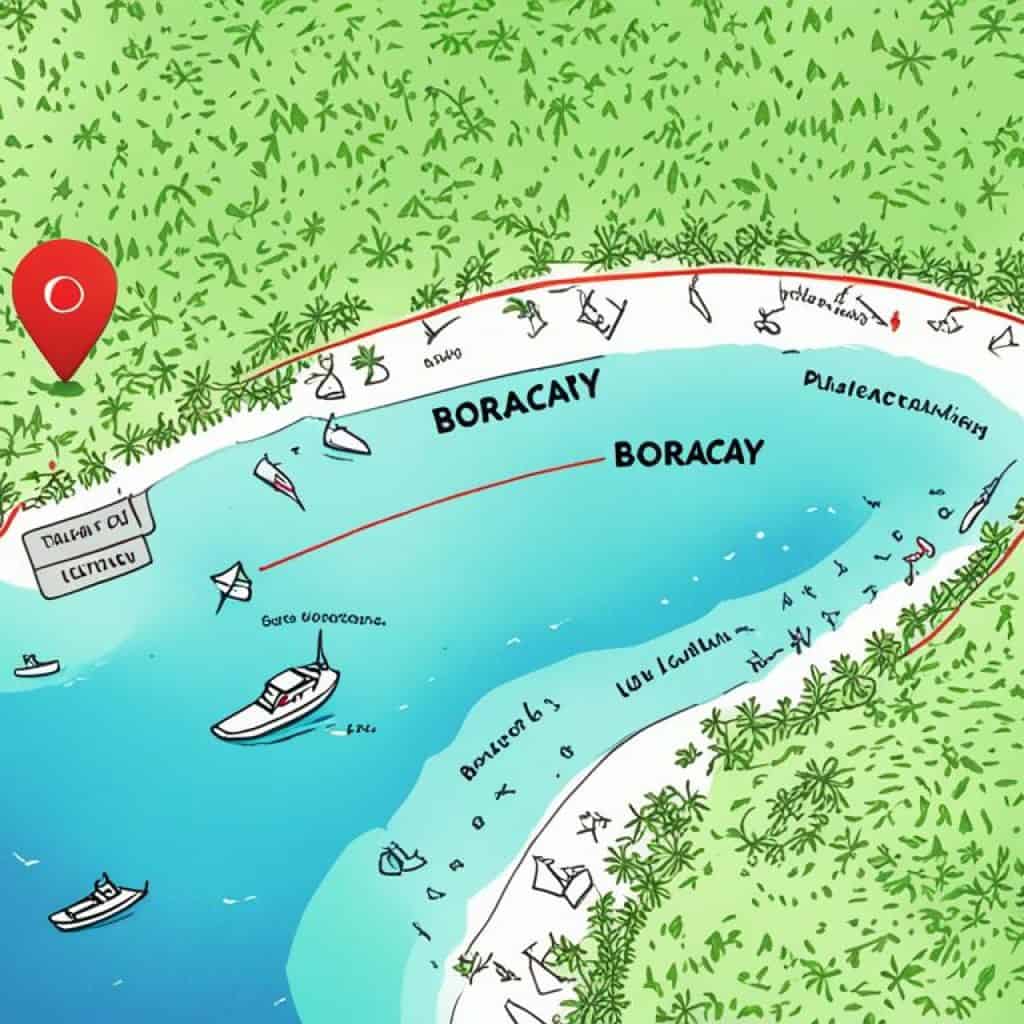
By utilizing these maps, you can navigate Boracay with ease, ensuring that you don’t miss out on any of the island’s incredible offerings. From stunning beaches to vibrant nightlife, the maps will guide you through this tropical paradise, allowing you to create memories that will last a lifetime.
Conclusion
Boracay, located off the northwest coast of Panay in the Philippines, is the perfect destination for beach lovers and nature enthusiasts. Despite undergoing closure and renovation, this renowned tourist spot continues to attract visitors with its pristine white sand beaches and vibrant atmosphere. Boracay’s commitment to sustainability and environmental conservation ensures that every traveler can have a memorable and responsible travel experience.
With its breathtaking natural beauty and crystal-clear waters, Boracay offers a slice of paradise that is hard to resist. Whether you’re seeking relaxation on the beach, thrilling water sports adventures, or lively nightlife, this island has it all. The closure and renovation efforts carried out in 2018 have further enhanced the island’s infrastructure and environmental sustainability.
As you explore Boracay’s stunning beaches and immerse yourself in the local culture, you’ll be surrounded by a sense of tranquility and beauty that is unparalleled. From the moment you set foot on this tropical island, you’ll understand why it has received acclaim as one of the best destinations in the world. So pack your bags and get ready for an unforgettable experience in Boracay!
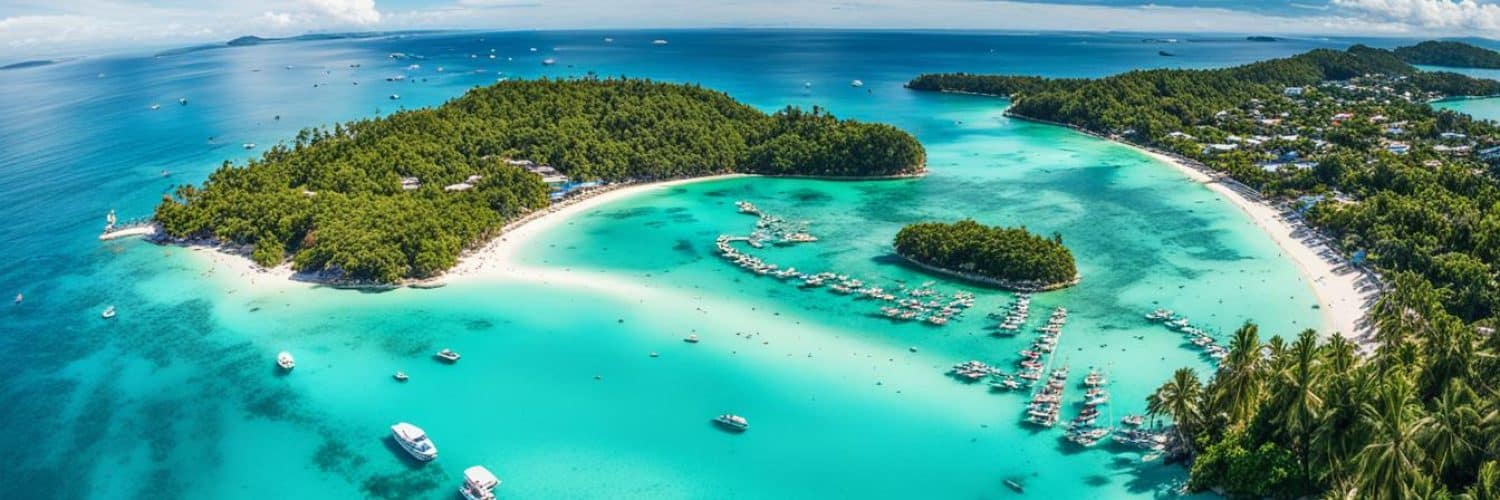
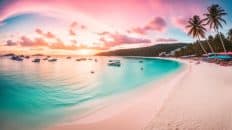
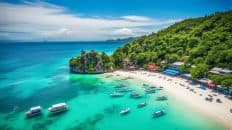
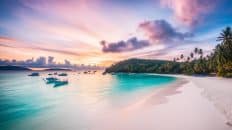














Add comment